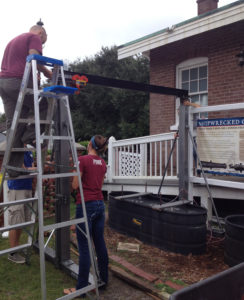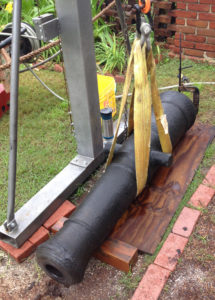As part of an exhibit project sponsored in part by the Department of State, Division of Historical Resources and the State of Florida, two of the largest and most recognizable artifacts at the St. Augustine Lighthouse & Museum are currently undergoing a little extra conservation.
Visitors to the lighthouse have seen two cannons outside of the Keeper’s House for the last few years. The 4-pound long gun and the 9-pound carronade were excavated in the summer of 2011 from the “Storm Wreck” by the Lighthouse Archaeological Maritime Program (LAMP). Shortly thereafter, they were delivered to the lighthouse with a number of other artifacts.

Setting up the gantry to move the 4-pound gun.
The guns were then mechanically cleaned with hammers, chisels and pneumatic airscribes to remove the outer layers of sediment and marine growth, called concretion. Removing this material significantly speeds up the next step of the conservation process. When the artifacts are as clean as can be without being damaged, they are put into electrolysis.
The electrolysis process consists of putting the artifact in an electrolyte solution and running an electrical current into the object. This helps remove salt from the metal and helps inhibit future corrosion. The amount of chlorides in the solution are monitored by titration testing. This allows us to see when the solution needs to be changed and when the artifact is done.
That step is where the long gun and the carronade have been for the past three years.

The long gun strapped and moved into position.
In order to further speed up the process, the concretion from inside the bore is now being removed. The front of the muzzle was airscribed and cleaned in order to take accurate measurements of the bore diameter. Using these measurements, a large hollow-core drill bit was custom-made by Xynides Boat Yard (located here in St. Augustine, Fla.) to fit into the bore and help chisel out the concretion.
The drill bit was screwed onto a metal shaft and a heavy, almost solid pipe slid onto the shaft to act as a slide hammer. By sliding the hammer forward and hitting the back of the drill bit it would slowly chip away the concretion and by sliding the hammer back it would release out of the bore.
This process took a number of days pulling the cannon out with the gantry, working on the bore and then putting it back into solution. While the drilling and chiseling was very hard work, the thick concretion was fortunately concentrated at the front end of the muzzle. Once the drill bit was able to break through the hardened section, the remaining debris was mostly clay and soft silt and was very easy to remove. Any remaining sediment will now be cleaned using a solid bar anode placed down the center of the bore.

Using the slide hammer and drill bit.
Sadly, after removing and cleaning nearly all of the bore, it is evident the long gun was not loaded. However, we do have other cannonballs recovered from the “Storm Wreck.”
Now that the 4-pound cannon has been cleaned, the next step is to move the gantry and start the whole process over again with the carronade.
At this point, we are planning to begin cleaning the 9-pound gun around the second week of November. Stay tuned for further details or come by and see the conservation process up close!
Andrew Thomson is the Assistant Conservator for the St. Augustine Lighthouse & Museum. He received his graduate degree and training from the Conservation Research Laboratory at Texas A&M.

